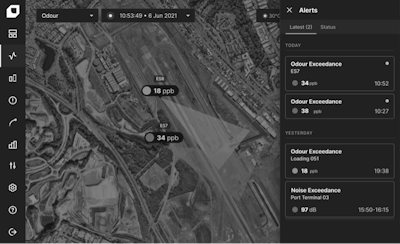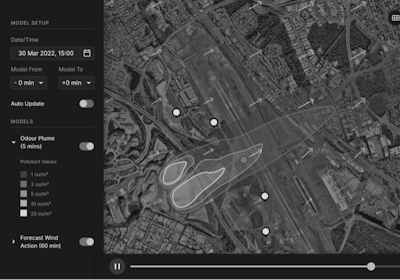Any possibility of slightly reducing odour impact can save navigating the fallout of a disruptive situation for waste management operations and local communities.
However, odour is notoriously difficult to measure and manage. Moreover, limiting the impact of offensive odours is a tedious task.
Investigations to identify problematic emissions sources within an operation take a significant amount of time. The context can instantly shift thanks to mother nature. Weather conditions can change at the drop of a hat, intensifying odour emissions at an exponential rate.
When incidents occur, landfill operators need to respond quickly and effectively. This only becomes possible when decision makers have access to real-time data that can be interpreted accurately to mitigate odour incidents quickly.
The benefits of swift and targeted incident mitigation aren’t hard to see. Whether it’s reducing the number of community complaints, maintaining your social licence to operate, or keeping unscheduled downtime to a minimum, there are plenty of reasons that many waste management operations see effective odour management strategies as an invaluable but often costly investment in their budget cycles.
Mitigating risks with advanced odour management strategies
While waste management operations exist to benefit growing communities, an inevitable by-product of dealing with solid waste is unpleasant and potent smells. One of the main challenges waste management operators encounter daily is keeping odour emissions contained within the site boundaries.
Balancing community expectations, operational output and regulatory compliance is no easy feat. Moreover, odour sensitivity varies from person to person. Even in low concentrations odour can sometimes cause headaches, eye, nose and throat irritation and nausea.
Odour management is only further complicated by the fact that many easy-to-implement strategies—keeping buffer distance between operations and communities—are no longer adequate. Residential areas are continuing to grow in close proximity to landfills and there’s less room for error.
However, as new complexities emerge, there’ve also been significant advancements in odour management technologies. Techniques for keeping odour at bay are becoming increasingly sophisticated.
It’s now easier than ever before for subject matter experts and non-experts alike to proactively mitigate risks by arming themselves with the tools needed to instantly diagnose the source of the problem and implement faster, more effective action.
Odour management strategies that can be used for risk mitigation at waste management operations
1. Odour emissions modelling to stay ahead of unfolding weather risks
With real-time, accurate odour management software at their fingertips, operators at waste management sites can navigate weather risks with confidence.
Environmental management software such as EVS Omnis is supported by hyperlocal, site-specific weather data. It enables operators and management staff to model odour impact and concentrations for up to 72 hours in advance to plan for periods of high risk.

Operators are now using insights to make better informed decisions and are better equipped to proactively manage odour risks.
They are now able to plan for shifts with the highest weather and odour risks ahead of time. Work that is the least likely to cause issues can be scheduled during higher risk periods.
2. Transparently managing and reducing community complaints
Maintaining positive relationships with nearby communities is an essential part of complaint response and protects your company’s social licence to operate.
When communities experience chronic odour issues and begin pointing fingers at local waste management or industrial operations, regulators may be prompted to intervene. This can result in more disruptions and unscheduled downtime while investigations on the cause that leads to appropriate resolution. Schedules or deadlines may become more difficult to stick to, leaving operators working at full speed to make up for the lost time.
Communities are becoming increasingly impatient about slow and indecisive responses to odour complaints. By leveraging industry-leading forecasting techniques through the use of odour management software, such as Envirosuite’s EVS Omnis, site operators are empowered to make swift, informed decisions that show nearby communities that they’re responsible, reliable and that they prioritise the expectations and needs of those in surrounding areas.
Advanced odour management software also supports greater collaboration and trust between industry and community, leading to community engagement. There are five stages of community engagement, beginning with disengagement and ignorance. Ideally, waste management sites want to work towards stage five, which is collaborative engagement.
Collaborative engagement supports high community involvement, with transparent communication that invites individuals to become a part of the conversation. Environmental management software such as EVS Omnis provides a web portal for communities to engage with waste facilities directly. Stakeholders can have a productive conversation with the potential to result in positive action without the need for further regulatory action.
3. Acting on smart alerts to prevent threshold breaches
Breaching odour intensity thresholds is an ongoing risk for waste management operations. Environmental management software can provide operators with the peace of mind that comes with knowing they will be alerted of potential emission issues.
Environmental intelligence platforms like EVS Omnis enable operators to set alerts for odour threshold breaches, so that they receive early warnings of potential exceedances that could lead to community impact.
Waste sites can avoid being caught off guard and only finding out there’s an issue when complaints are lodged, instead of being in control by staying ahead of the issue.

Smart alerts based on actionable insights from weather and emissions data can be used to make necessary operational adjustments to limit impact. As such, operators can minimise any impacts on the community and avoid compliance breaches as well as costly investigations.
4. Refuting responsibility for invalid complaints regarding odour
High volumes of community complaints can pose a serious burden on the employees responsible for investigating and following up on every complaint.
Waste management operations can often be the first blamed for potent smells in the community. When this happens, it can put a strain on community relationships with residents affected by the problem.
However, it’s important to remember that odour perceived in the community isn’t always necessarily coming from your waste management operation. Often it can be coming from another operation or from natural causes.
it’s important to have reliable information available to readily refute or accept responsibility. Modern odour management software, such as EVS Omnis, helps your site shorten investigations using innovative capabilities such as reverse trajectory modelling. This enables investigation teams to start at the location of the complaint and work backwards to pinpoint the source of the issue.
EVS Omnis displays actionable insights in an easy-to-understand interactive dashboard for non-subject matter experts to interpret. This information empowers waste management operators to avoid spending time and resources on a lengthy interpretation process.
In addition, defensible data ensures that users can confidently refute responsibility of odour complaints directed at their site.
Case study: Supporting odour management and risk mitigation with environmental intelligence
A North American waste management agency, situated near other heavy industry operators and residential community, needed to find a way to confidently confirm or refute responsibility of odour emissions at the landfill with hard evidence.
Established in the 1970s, the regional agency plays an integral role within their community. They manage their jurisdiction with the highest regulatory and environmental standards to confidently collect, process, treat, recycle, and dispose of waste within the area. As with most waste facilities, a key concern is odour emissions due to their impact on neighbouring communities.
The waste management team needed to find a way to transparently demonstrate operational compliance and educate community citizens on the odour issues.
With EVS Omnis the waste management authority was able to:
Assess odour problems swiftly using real-time visualisation of environmental parameters;
Receive early warnings of potential breaches;
Access site-specific weather data to inform operational decisions;
Utilise reverse trajectory modelling to work backwards and determine the source of complaints;
Refute or confirm responsibility for odour issues;
Customise and automate reporting for odour compliance;
Demonstrate transparency to stakeholders.
Envirosuite’s environmental intelligence software for proactive odour management
Envirosuite’s easy-to-use environmental management software—EVS Omnis—is the modern-day proactive odour management solution at landfills and composting sites.
The platform combines cloud computing, operational meteorology and human ingenuity for a thorough and highly accurate solution to support proactive odour management. EVS Omnis translates complex air quality data into actionable insights, making the odour management approach far more accessible.
With EVS Omnis, operators can act on site-generated emissions, plan operations around unfolding weather and engage transparently with stakeholders — without burning through limited resources.
Access real-time visualisation of site-generated odour emissions and unplanned stoppages;
Use predictive insights from air quality dispersion modelling to plan operations with confidence around odour risk;
Engage with stakeholders using defensible data to respond to complaints, collaborate, co-exist and maintain trust;
Schedule higher-risk operations during optimal weather conditions to reduce the likelihood of odour breaches and keep impacts to a minimum.
Contact our team to discuss your requirements and take the first step towards improving odour management at your waste management operations today.
